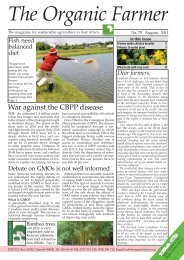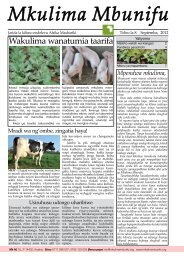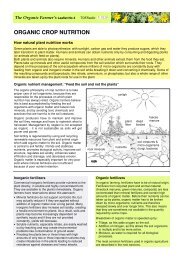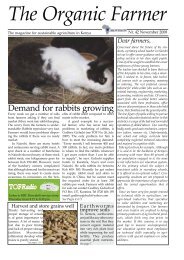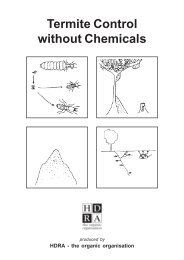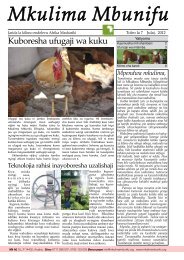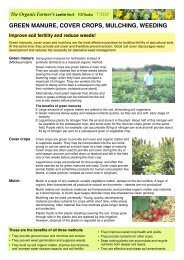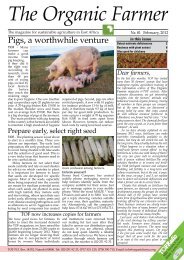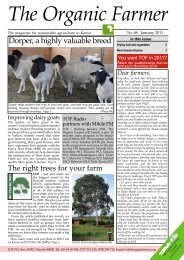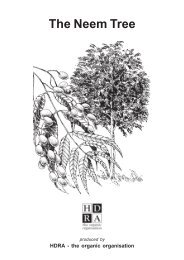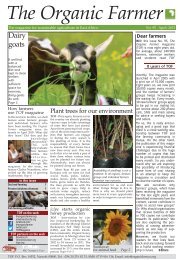TOF, Issue No 33, February 2008 - Infonet-Biovision
TOF, Issue No 33, February 2008 - Infonet-Biovision
TOF, Issue No 33, February 2008 - Infonet-Biovision
You also want an ePaper? Increase the reach of your titles
YUMPU automatically turns print PDFs into web optimized ePapers that Google loves.
Nr. <strong>33</strong> <strong>February</strong> <strong>2008</strong>Know banana diseases and control themUsing clean material and plantingdisease-resistant varieties can helpcontrol most of the banana diseases.Michael WaweruBanana diseases are on the increaseand farmers need to take preventivemeasures to control them. Thepractice of sharing planting materialis mainly to blame for the spread ofdiseases from one area to another.Lack of information on the diseasesis yet another problem because mostfarmers do not take preventive measuresto contain the diseases. The followingare the most common diseasesresponsible for declining production inmost of the banana producing areas:Panama diseases (fusarium wilt)Panama disease, also known as Fusariumwilt of banana, is caused bythe fungus Fusarium oxysporum f.spcubense which attacks the pseudostemand corms of susceptible cultivars. Thefact that the pathogen remains in thesoil for up to 30 years after the soil isinfested makes the Panama diseaseone of the most devastating bananadiseases. The pathogen occurs in threeraces (Race 1, 2 and 4). Race 4 is one ofthe most dreaded because Cavendishbananas, that are resistant to other racessuccumb to it. The most susceptiblecultivars are Gros Michel (Kampala),Apple banana (sukari ndizi), Mararu,Bluggoe (Bokoboko) and Psian Awak.Tolerant varieties in Kenya includeKiganda and the Cavendish group, e.gNyoro.It is a soil-bourne disease.Symptoms & effects•Yellowing of leafs, beginning alongthe margins and advancing towardsthe midribs.•Yellowing progresses from older toyounger leaves as the plant dries up.Panama disease: branches hang from the stem•Leaf petioles turn brown and bend orbecome twisted (buckle).•Brown spots of various shapes andsizes appear on the yellow leaves.•Pseudostem frequently split longitudinallyjust above the soil level.•Outer leaf sheaths may separate fromthe pseudostem and collapse.•Diseased rhizomes and pseudostemsrelease offensive smell due to rotcaused by secondary pathogens•Discoloration of the vascular tissue(red)Control•Cut off the affected part of the plantand burn them.•Reduce movement of infested soilfrom the area around the plant, usesoil conservation methods.•Treat the banana corm (root base)with hot water; this reduces thedisease by 20 %.•Sterilize garden tools by placingthem over fire flames to reduce spreadof the disease.•Plant disease-tolerant varieties, e.gCavendish.Black SigatokaBlack Sigatoka (black leaf streakdisease) is one of the most devastatingleaf spot diseases in the world. Itis a major problem in Western Kenyacausing a yield loss of up to 50%. Theleaf spot disease Black Sigatoka iscaused by the fungus Mycosphaerellafijiensis. It is spread by spores carriedin the wind. Black Sigatoka spores caninfect all the banana plant includingleaves, suckers used for planting aswell as leaf litter. It is more damagingand difficult to control than therelated yellow Sigatoka disease.Symptoms & effects•Young leaves are mainly infected.•Initial symptoms are thinly blackstreaks (1-2 mm) on the underside ofthe leaves which enlarge to 5-10 mmwith no distinct border.•The streaks form black leaf spotsthat later merge to kill the entire leaf.•Premature ripening of the bananabunches.Yellow sigatokaThis is also a leaf spot disease causedby mycosphaerella musicola. It resemblesblack sigatoka but yellow borderssurround the streaks..Symptoms & effects•Initial symptoms are pale yellowstreaks on the upper side of the leafsurface that enlarge to form deadEarly signs of black sigatokaareas with yellow holes and greycentre.•The disease resembles Black Sigatokain every other aspect.Control of black and yellow sigatokaBlack and yellow Sigatoka diseasesare very difficult to differentiate andmay even occur together on the sameplant.•The use of clean planting materialssignificantly reduces the spread.•Remove affected leaves and burnthem.•Create adequate spacing of plants.•Open up the canopy by pruningsince sunlight discourages the germinationof the fungus that causesSigatoka.Cigar–End RotCigar-end rot (verticillium theobromae)This is a fungal disease, which isincreasingly becoming a more evidentdisease in Kenya especially in Kisiiand Western Kenya. The Dwarf Cavendishand Gross Michel varieties areparticularly susceptible.Symptoms & effects•The bananas appear as rot on immaturefingers with an ashy appearance(spores) on fruit tips. This rot lookslike the tip of smoked cigarette, hencethe name.•The rot affects a few centimetresof the banana fruit tip and becomesbigger with the fruit growth. Neem•The pulp develops a dry rot andbecomes fibrous.continued on page 7
Nr. <strong>33</strong> <strong>February</strong> <strong>2008</strong>Take great care during seed purchaseIn order to save money, many farmersfall for cheap seeds on offer by middlemen– only to end up with a poorharvest.The Organic FarmerAs the planting season approaches it isimportant that farmers decide on theinputs they require in order to increasetheir production. Chief among theinputs are seeds. Sound knowledge ofthe right seeds to buy is very importantbecause low quality seeds reducethe maize yield at harvest. Variationsin altitude, rainfall, type of soil andtemperature require a careful selectionof seeds that perform well underspecific local conditions. To cater forthe different regional growing conditions,different seed varieties havebeen developed and are available instock. Therefore, farmers should knowthe type of seed that is most suitablefor their geographical area beforebuying any seed. To know the type ofseed required, it is important to seekguidance from agricultural extensioncentres or research institutions nearthem. Fortunately, some farmers knowthe right varieties for their areas andcan provide useful advice to fellowfarmers.Seed companies confuse farmersThe main problem with the selectionof seeds among farmers is the increasingnumber of companies that haveSeed selection determines the quality of maize.entered the market with different varietiesof maize. The aggressive mar-tactics and end up buying the wrongfarmers fall prey to these marketingketing of new seed varieties being seeds. This cheating is to blame forintroduced every year makes it very the decreasing maize yield and newdifficult for farmers to select the right diseases that now affect maize in manyseed varieties. The result is that most parts of the country.Important tips for seed-buyersBefore buying seeds, farmers shouldconsider the guidelines below tomaximise yields in maize production:- They should only buy seeds fromseed stockists who are licensed tosell seeds. The farmers should insiston seeing the licence if they do notknow the stockist well. Alternatively,they should buy seeds from wellknowndistributors in their areas. Acertified seed stockist will rarely sellfake seed.- All genuine seeds have companytags and the labels of the Kenya PlantHealth Inspection Service (KEPHIS)inside the seed bags. To ensure thatthe seed is genuine, farmers shouldverify that tags and KEPHIS labelsare present when they open the seedbag.- Each seed company has its owncolour to distinguish their seeds fromthe rest. Farmers should be able totell the colour of the seeds from differentcompanies.- Farmers should buy their seedsearly enough to avoid last minuterush. They should remember thatfake seeds are mainly sold aroundMarch and April every year whenthe popular varieties of maize seedare sold out.- All seeds should be stored in a cooland dry place.- Maize seed is treated with dangerousfungicides and insecticides. Itshould never be eaten!A clever farmer who intends to buy anew seed variety first of all tests thequality of the seed. He isolates a smallportion of land where he can plantthe new variety. He should observewhether the maize is prone to lodging(falling), if the ears open early, which isresponsible for decay, and if the varietygives a good yield in that particulargeographical region. When the farmeris convinced of the seed quality, thenthey can use the seed the followingyear. But they should not forget thateven with good quality seeds, theywill only obtain good yield if the cropis well managed. Low soil fertility,late land preparation, poor weedingand even wrong seed application canmarkedly lower maize yield.Beware of "Dubai seed"Another mistake made by mostfarmers is the use of uncertified seedcalled “Dubai seed”. Dubai seed ismainly sold by middlemen, who offerit to farmers, claiming that the seed isobtained from seed growers. Investigationsestablished that most seedgrowers usually sell the seeds evenif seed companies, which contractedthem to produce the seed, reject it.The seed may be rejected becauseit does not meet the quality standardsof the companies. When theseed is rejected, the seed producersare advised to sell it as commercialmaize. But most of the growers donot do so. Instead, they sell the maizeto middlemen who offer it to farmersas genuine seed. Eventually farmersbear the consequences of poor yields.Due to lack of resources, manyfarmers use their commercial maizeas seed with the hope that with goodmanagement, they will still obtain agood harvest. Such farmers shouldknow that maize seed is producedin a particular way that enables it toproduce more when planted. Commercialmaize does not have thesequalities. Therefore, it will give a verylow yield when used as seed. Commercialmaize is also responsible forthe transfer of diseases and pests suchas leaf inflammation, stalk and thelarger grain borer. Some unscrupuloustraders buy commercial maize,treat it with the same chemicals andpackaging used by seed companiesand then sell it as genuine seed. Insuch a case, it is very difficult forfarmers to tell whether the maize seedis genuine or not.



